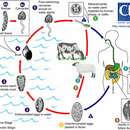en
names in breadcrumbs



Trematoda (Flukes) is a class of flatworms. There are 5968 species of Flukes, in 1166 genera and 101 families. They have asexual reproduction. They rely on ciliary gliding to move around.
EOL has data for 12 attributes, including: